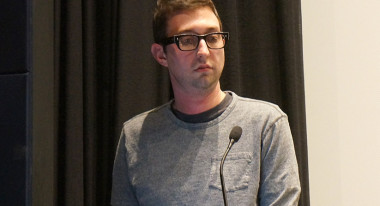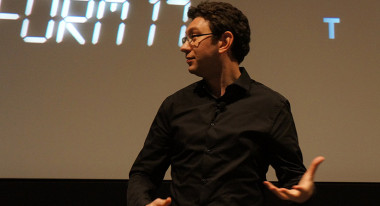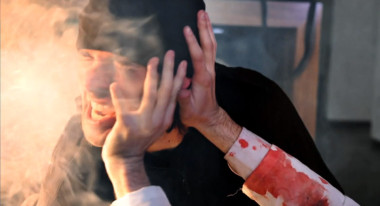 Back to selection
Back to selection
The Week In Cameras
Latest News About the Tools We Use by Michael Murie
Tempo: A budget VFX lesson from Seth Worley and Red Giant

Red Giant is known for their effects software, including Magic Bullet Looks, Colorista and Trapcode Particular. But they are also developing a name for themselves with a series of short films that are both entertaining and great demos of how-to-do effects on a budget. It probably doesn’t hurt that they also demonstrate how to use their software too!
Director Seth Worley and Aharon Rabinowitz, director of Communities at Red Giant, spoke at a recent meeting of the Boston Creative Pro Users Group about the production of their latest short, Tempo.
Worley first came to Red Giant’s attention when the company was looking for a way to talk about its products “without being obnoxious,” according to Rabinowitz. After coming across a video Worley had done as an entry in ABC’s “Ultimate Lost Fan Promo” contest, he also saw “Adventure Now” a web series Worley had directed. In the documentary on the making of the series, Worley said that he’d made the series for a ridiculously low amount of money. Said Rabinowitz jokingly, “That’s the guy I want to work with!” “But,” continued Rabinowitz, “we didn’t want to throw $100,000 at a film. We wanted to throw the amount of money that people have.” This collaboration resulted in the short Plot Device, which was produced for $10,000 and became a viral hit. Worley now works for Red Giant, and Tempo is the fourth short he has directed for the company.

The idea for Tempo came from a sci-fi gun used in the Adventure Now series. The device could slow down or speed things – and people – up. “I never thought we used it appropriately,” said Worley. “We had wanted to do an entire fight sequence in a kitchen… and we never got to explore it very much.”
While they want to make movies that are fun, “we need to relate it to the products we’re doing,” said Rabinowitz. “At the end of the day that’s where we get our funding to do these films.” Fortunately, Peder Norrby, the developer of Trapcode Particular had been working on some new features, including particles that are generated by the direction that things are moving in a clip. This seemed like something that could be used for some of the effects in the new movie.
Pre-production started at the beginning of October, right after the last short, Forum 17, was posted. The shoot occurred on the last weekend of October, with two days of principle photography and a half-day of pick-up shots. Post-production ran through the month of November, and the movie was posted the first week of December.

It’s clear that Worley and Rabinowitz spend a lot of time experimenting and working on the effects before doing the actual shoot. The slowed-down fire caused by a grenade in one scene posed a particular problem because it’s so hard to pull off synthetic fire. “Every test looked hokey,” said Worley. “Everything that was locked off immediately looked fake. I needed to be able to move the camera a lot, which was going to give away the 2D stock elements pretty quickly.”
Rabinowitz finally used a real clip of fire, sped it up, and then built a particle system in Trapcode Particular using that element. After experimenting with blend modes and adding motion blur, he had something that looked very real. Two other interesting techniques involved building a swarm of bees and putting a cow in a laboratory. The later proved particularly difficult, said Rabinowitz. “The script said we’re going to have a cow, and Seth sends me the plate and we don’t have a cow.” Going in search of a clip of a cow, Rabinowitz thought, “there’s got to be hundreds of greens screens of cow.” Piped in Worley, “There so is not!”
Two tutorials on Red Giant explain in great depth how they created the cow and the bees. Episode 91 – Tempo: Fresh Meat – Keying & Compositing the Cow, and Episode 90 – Tempo: The Bees Knees – 3D Bee Swarm w/ Slow Motion FX.
Practical Effects
While these moves are showcases for visual effects on a budget, both Worley and Rabinowitz stressed the importance of adding practical elements as much as possible. For a gun shot through a computer laptop screen they drilled a hole in an old PowerBook, then had some Sweet’N Low on a surface behind the hole and gave the actor some compressed air to blow the powder through the hole.

When they were shooting the fight in front of the exploding grenade, they had a yellow light shining on the actors from the point where the explosion was supposed to be. This added a warm glow to the actors that went with the visual effect that was later added. “I took every opportunity I could to put a practical element in to an effect,” said Worley.
Shot on the Canon 5D Mark III by d.p. Mark Coward, the project did have four p.a.s from the Nashville Film Institute. “We’ve never had p.a.s before, which helped us tremendously,” said Worley. Because of the limited availability of the location and the lead actor, Darren Vandergriff, who lives in D.C., they only had two days of principal photography, which made for a very rushed shoot. They did gain a half-day of pick up shots with Vandergriff thanks to Hurricane Sandy.

Directing a project without the luxury of time can be stressful. “My job on set as the director is to constantly tell people that the hard work they are putting in to it is not worth it. That’s what I feel like. I feel like I’m the one who’s constantly saying, ‘Hey, I know you’re working really, really hard but stop. No one’s going to notice that. We need to film something.’”
With the shoot completed and the effects added, it was time for color correction. “Every look we tried on this movie just looked forced,” said Worley. “That we were trying to make it look like Minority Report or trying to make it look like Bourne.” Finally, they did just a straight color-correction pass, but Worley felt the results still looked “too blue.” So they removed the cyan and the blue from most of the shots and ended up with what he described as a stylishly sterile look for the lab.
The last effect they described was the use of their Retrograde product to turn the “test” videos at the opening into “shitty film.” Rabinowitz joked that after years spent getting video cameras to look good, everyone is now turning video into shitty film, “and we did it too.” He continued, “And why might you ask are we using archival footage in a film that takes place now? We have our reasons!”
“We thought about it,” said Worley. “It’s to decrease the chance of duplication. Of course they are watching it on a digital presentation so they obviously digitized it.” Added Rabinowitz, “I also thought about that and I said, look people are going to want to look at these videos and see this crazy stuff happening. If you show them the film there’s nobody that can deny that it’s the real thing.”
While talking about process, Worley explained that he is a fan of “making of” books and videos, confessing to having bought The Making of Jurassic Park book three times. “I’ve cut stuff out of it and I’ve highlighted stuff. Jurassic Park is my favorite movie.”
“We want to create tools that people use, teach them how to use them with Red Giant TV, and provide inspiration for people using our software to go out and make their stuff,” concluded Rabinowitz.
